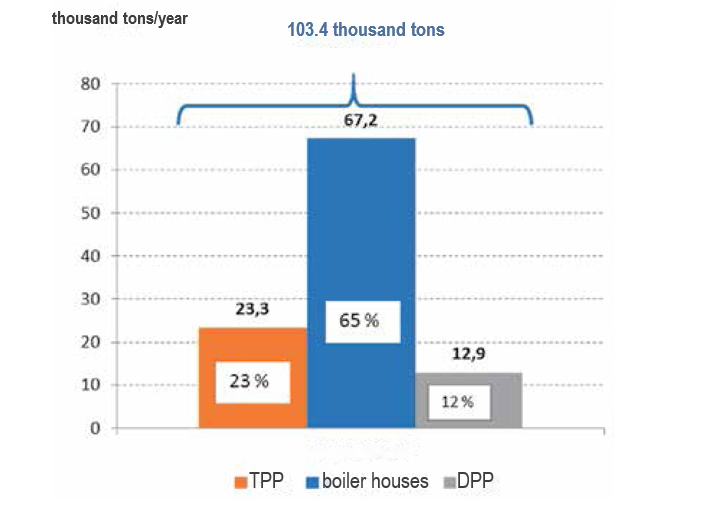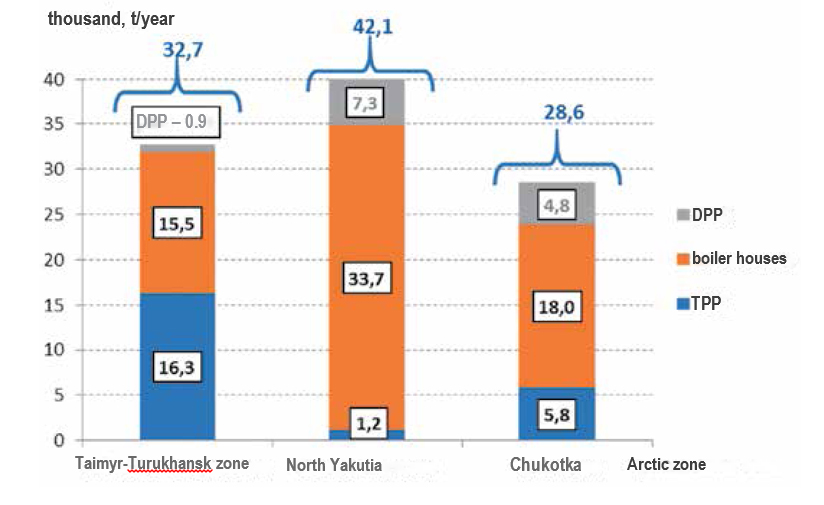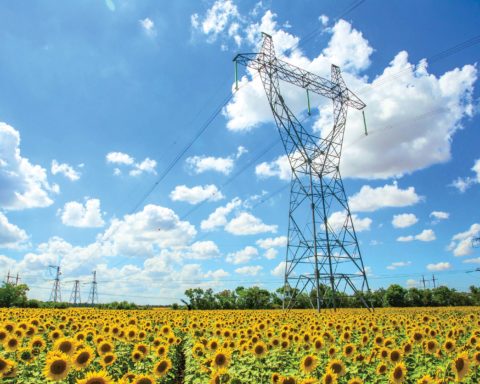Elena MAYSYUK
PhD of economy, Senior researcher,
Melentiev Energy Systems Institute SB RAS, Irkutsk
e-mail: maysyuk@isem.irk.ru
Irina IVANOVA
PhD of economy, Senior researcher,
Melentiev Energy Systems Institute SB RAS, Irkutsk
e-mail: nord@isem.irk.ru
Introduction
The analysis of the current state of the natural environment is carried out on the basis of data from the state reports “On the Environmental Protection of the Russian Federation” [1] and the RF constituent entities [2-4] in whose territory the settlements of the eastern sector of the Russian Arctic are located. This sector includes the territories of the north of three constituent entities of the country: Krasnoyarsk Territory (Taimyr-Turukhansk Arctic zone), the Republic of Sakha (Yakutia) (North Yakutsk Arctic zone), and the Chukotka Autonomous Okrug (fully included in the Arctic zone).
The study examines the release of pollutants into the atmosphere, bodies of water and soils in the form of industrial and household waste in the statistically-available for 2018, since data for a later period have not yet been published.
Along with the assessment of pollutant emissions, greenhouse gas emissions into the atmosphere were also analyzed, in particular – the release of carbon dioxide, as the main ingredient in emissions from stationary fossil-fueled sources.
In addition, the study identifies the main sources of emissions of pollutants and waste, and evaluates the contribution of energy facilities to the total impact on the environment.
The current state of the natural environment
The amount of pollutants from stationary sources released into the atmosphere of the eastern sector of the Russian Arctic in 2018 amounted to 1.91 mln. tons, with the predominant contribution of the northern areas of Krasnoyarsk Territory (98%); the discharge of effluents into surface bodies of water and rivers is estimated at 196.4 mln. m3 – also with a predominant share of Krasnoyarsk Territory (83%) – and the amount of generated waste is 38.3 mln. tons, where the bulk comes from the Chukotka Autonomous Okrug (54%) (Table 1).

Note: * – the figures are summarized for the largest enterprises, compiled on the basis of information from state reports on environmental protection [1-4]
Taimyr-Turukhansk zone
The main centers of economic activity in the Taimyr-Turukhansk zone are the Norilsk industrial region (MMC Norilsk Nickel) and the Vankor oil and gas field (Turukhansk region). In 2018, 1.8 million tons were released into the atmosphere from Norilsk Nickel, where about 98% of the total amount was sulfur dioxide. In addition, in 2018, an inventory and assessment of greenhouse gas emissions from enterprises of the Norilsk Nickel group of companies was carried out based on the requirements of the corporate standard for accounting and reporting of the protocol on greenhouse gases. Greenhouse gas emissions are estimated at 10 million tons of CO2-equivalent (accounting estimate, which includes emissions of carbon dioxide (CO2) and methane (CH4)) [5].
The production of hydrocarbons in the Arctic zone of Krasnoyarsk Territory is carried out by RN-Vankor and Norilskgazprom, as a result of which in 2018, 56.2 thousand tons of pollutants were released into the atmosphere [2].
The main indicators characterizing the impact of enterprises on bodies of water are intake, use and the discharge of wastewater into surface bodies of water. According to the enterprises of MMC Norilsk Nickel group, water intake is carried out in accordance with the established limits and does not have a significant impact on bodies of water [5]. Wastewater from the company’s facilities is mainly discharged within the established limits.
According to the state report on environmental protection in Krasnoyarsk Territory, there are no wastewater discharges, including contaminated ones, in the Turukhansk region.
Waste in the Taimyr-Turukhansk zone is generated by the operations of large enterprises. Thus, in 2018, the operations of Norilsk Nickel resulted in the generation of 15.7 million tons of waste, classified as hazard-class 5 (non-hazardous). The waste is comprised of rock and overburden rocks, mill tailings and metallurgical slag. Almost all waste from mining and processing is located in equipped waste disposal facilities and is used in economic activities [6].
Analyzing the information on the amount of waste generated by Rosneft in 2018 in the amount of 6.2 mln tons, it can be concluded that waste from hydrocarbon production at the fields of the Vankor cluster will be no more than 9% or 0.5 mln. tons [6].
North Yakutsk zone
The economic development of the Arctic zone of the Republic of Sakha (Yakutia) is associated with the development of mineral resources oriented towards transportation along the Northern Sea Route. Environmental data for 2018 is given for 13 uluses (administrative areas) included in the Arctic zone of the Republic of Sakha (Yakutia): Abyisky, Allaikhovsky, Anabarsky, Bulunsky, Verkhnekolymsky, Verkhoyansky, Zhigansky, Momsky, Nizhnekolymsky, Oleneksky, Srednekolymsky, Ust-Yansky and Eveno-Bytantaysky. In 2018, 18.2 thousand tons of pollutants were released into the atmosphere, with the highest emissions in the Verkhoyansky (5.6 thousand tons) and Verkhnekolymsky uluses (3.3 thousand tons). In other uluses, emissions do not exceed 1,000 tons. The trapping of pollutants at stationary sources is virtually non-existent, except for two uluses (Anabarsky – 0.1%, and Ust-Yansky – 24.5%). In the structure of emissions from Arctic uluses, emissions of carbon monoxide (CO), volatile organic compounds and nitrogen oxides prevail. In four uluses, along with CO emissions, there is approximately the same emission of solid substances (Verkhnekolymsky, Verkhoyansky, Zhigansky and Ust-Yansky).
Wastewater discharge in the uluses of the Arctic zone of the Republic of Sakha (Yakutia) in 2018 amounted to 11.3 mln. m3. There are no data on discharges of polluted wastewater. Among the bodies of water in these areas, the rivers where wastewaters are discharged should be highlighted: Indigirka (classified as very polluted with a high content of petroleum products, iron and manganese), Anabar (very polluted, with an excess of iron, copper and manganese).
In 2018, there was a deterioration in the quality of water in the Kolyma river within the area of Chersky settlement (very polluted), as there are no operating sewage treatment plants in the settlements of the Nizhnekolymsky ulus. Wastewater is discharged directly into the Kolyma river. In the Verkhoyansk ulus, the water of Yuchugei creek has exceeded the standards and is characterized by an extremely high level of pollution in terms of the content of copper, zinc and manganese. Overages were found in the water of Kuuteen lake (Sulfidka lake) – pollutants are discharged into the lake from the tailing dumps of tin ore deposits at factory No. 418 of the Batagai mining and processing plant. Also polluted is the Olenek river in the Oleneksky ulus.
In general, in the Arctic zone of the Republic of Sakha (Yakutia), wastewater treatment facilities are operated in some settlements, but they do not provide wastewater treatment to the established standards for various reasons: overload in terms of wastewater volume, obsolescence and physical deterioration. In some settlements, wastewater is discharged without treatment.
In the Arctic zone of the Republic of Sakha (Yakutia), 1.5 million tons of industrial and household waste were generated in 2018; the largest volume was recorded in the following uluses: Momsky (679.3 thousand tons, due to enterprises for the exploration and production of gold), Ust-Yansky (167.2 thousand tons, due to the development and extraction of tin), Bulunsky (63.4 thousand tons), Nizhnekolymsky (15.6 thousand tons). In each of the remaining uluses, the volume of generated industrial and household waste does not exceed 2.5 thousand tons.
In addition, the key indicators that define the environmental situation were assessed for the main industrial centers or large enterprises, whose data is available in official statistics or on the websites of these enterprises. First and foremost, these include enterprises for the mining and processing of diamonds.
In 2018, in the Arctic zone of the Republic of Sakha (Yakutia), diamond mining was carried out by two subsoil users: ALROSA and Almazy Anabara. The amount of pollutants released into the atmosphere from these companies is estimated at 5.5 thousand tons, wastewater is estimated at 189.6 thousand m3, and 1.1 thousand tons of waste were generated. At the same time, 1.7 thousand tons of pollutants were released into the atmosphere from Almazy Anabara.
In 2018, ALROSA commissioned treatment facilities at the Verkhne-Munsky field, but the quality of water in the Lena river within the area of Kyusyur settlement has remained at the level of 2017 and is characterized as very polluted.
Another large company is Sakhaneftegazsbyt (sale, storage of petroleum products), which includes 19 branches in all Arctic regions of the republic with total emissions of 1.2 thousand tons of pollutants into the atmosphere in 2018.
Chukotka Arctic zone
On the territory of the Chukotka Autonomous Okrug, which is fully included in the Arctic zone, the state of the atmosphere is monitored in 2 cities (Anadyr, Pevek) at 2 observation stations. The emissions level is characterized as low. Total emissions from stationary sources in 2018 amounted to 23.2 thousand tons, where 32% were solids, 32% were CO emissions, 21% were sulfur oxides, 15% were others. In 2018, no measures were taken to reduce atmospheric emissions [4]. Sources of atmospheric air pollution in the settlements of the territory are facilities of the energy sector. All thermal power plants in the territory have flue gas treatment facilities in the form of cyclones with a cleaning efficiency of up to 85% [4].
In 2018, according to the state report “On Environmental Protection,” [4] 20 boiler houses of residential areas were operated in the territory, 3 of which are not equipped with dust and gas treatment facilities. In the Bilibino region, there are 7 boiler houses, 5 of which are solid-fueled, and only one has dust and gas treatment facilities with a flue gas purification rate of 20%. On average in the territory, the degree of pollutants capture from all emission sources in 2018 was 59.3%.
The discharge of effluents into surface bodies of water is 22.4 mln. m3, where 3 mln. m3 are discharged with insufficient treatment or no treatment at all. The territory’s centralized sewage drainage systems are implemented in 10 settlements (21.7%), while in the remaining settlements, sewage is collected in dump wells, and treatment facilities aren’t available at all wastewater outlets.
Waste from production and consumption in 2018 amounted to 20.6 mln. tons, 99% of which was hazard-class 5 waste (non-hazardous). The main companies contributing to the generation of industrial and household waste are: “Andesite” ( Ugolnye Kopu settlement), Mining and Geological Company, Karalveem Mine, Mayskoye Gold Ore Company, Northern Gold. More than 76% of disturbed lands are formed as a result of the development of mineral deposits, through construction work and waste disposal.
Estimation of greenhouse gas emissions
As is well known, in Russia’s Arctic zone, greenhouse gases are monitored at three stations:
Tireberka (Barents Sea coast), Novy Port (Yamal) and Tiksi (Laptev Sea) [1]. It is believed that the data from the Tiksi and Tireberka stations correspond to background values, while the large-scale production and processing of hydrocarbons takes place in Yamal, which can be attributed to anthropogenic values of greenhouse gas emissions. According to the state report on environment protection, at Tiksi station, the concentration of CO2 in 2018 was estimated at 411.3 mln-1 (according to the World Meteorological Organization, global average CO2 concentration amounts to 405.5 mln-1) and methane concentrations had an insignificant overage in comparison with data from other observation stations. In the summer period of 2018, abnormally high values of methane concentration were recorded, exceeding the characteristic regional background level. During the observation period at Tiksi station, a similar situation arose under the influence of large-scale fires, when, first and foremost, the concentration of carbon dioxide increased.
Greenhouse gas emissions in the RF at the end of 2017, except for absorption in agriculture and forestry, were 2.16 bln. tons of CO2-eq. The average per capita value of this indicator in Russia was 14.7 mln. tons of CO2-eq./person. The main source of emissions is energy generation associated with the combustion of fossil fuels, and in 2017, the emission of greenhouse gases generated from it amounted to 1,700 mln. tons of СО2-eq.; emissions from the transport of natural gas (leakage and evaporation of hydrocarbons) were 103.3 mln. tons of СО2-eq., emissions from production processes in metallurgy were 787.1 mln. tons of СО2-eq. [1].
Due to the lack of data on greenhouse gas emissions in the eastern sector of the Russian Arctic (except for the Norilsk industrial center), we use the average Russian CO2-eq. emission indicator to obtain an aggregated estimate. Based on the population in the areas in question, which was 162,572 people as of the beginning of 2018 (except for the people of the Norilsk industrial center), greenhouse gas emissions are estimated at 2.4 mln. tons of CO2-eq. Thus, total greenhouse gas emissions for the eastern sector of the Russian Arctic can be estimated at 12.4 mln. tons of CO2-eq.
Environmental assessment of the functioning of energy sector facilities
Emissions of pollutants into the atmosphere were calculated on the basis of data on fuel consumption at the power facilities of the territory in question (Table 2), using the calculation models available to the authors, on the basis of the methods approved in Russia [7-8]. The calculation took into account the qualitative composition and environmental assessment of the fuels used [9].

Note: compiled on the basis of Rosstat forms 6-TP “Information on the generation of heat and electricity by generating facilities (power plants)” and 4-TER “Information on the use of fuel and energy resources” in 2018, taking into account company data and expert assessments
It is assumed that flue gas treatment is only implemented at TPPs. Thus, on average for TPPs in the North Yakutia zone, the calculation assumes the rate of solid-particle trapping to be 60%; in the Chukotka Arctic zone, according to the data of the state report on environmental protection, it is 85% on average for power plants [4]. There is no flue gas treatment in the boiler houses of all of the constituent entities in question. Pollutant emissions into the atmosphere were calculated for four polluting ingredients typical for the energy sector: solid particles, sulfur dioxide, nitrogen oxides and carbon monoxide.
Total emissions of pollutants into the atmosphere of the eastern sector of the Russian Arctic from energy facilities as of 2018 are estimated at 103.4 thousand tons, where 65% are from boiler houses, 23% – from thermal power plants, and 12% – from diesel power plants (Fig. 1).
In the context of the territories in question and depending on the types of fuel burned, emissions amounted to: 32.7 thousand tons in the Taimyr-Turukhansk zone (with a slight preponderance of emissions from gas thermal power plants in comparison with other sources of emissions), 42.1 thousand tons in the North Yakutsk zone (with the largest contribution from boiler houses), and 28.6 thousand tons in Chukotka (with a predominance of emissions from boiler houses), Table 3, Fig. 2.


In the Taimyr-Turukhansk zone, emissions by categories of energy facilities are distributed as follows: approximately 50% are from TPPs and boiler houses, and less than 3% are from diesel power plants. A significant amount of pollutants is emitted into the atmosphere from the boiler houses of the North Yakutsk Arctic zone, which is about 80% of the total emission of this zone. Accordingly, 17% are emissions from diesel power plants and 3% are from thermal power plants (namely, the Deputatskaya CHPP). In the atmosphere of the Chukotka zone, 63% of all pollutants come from coal-fired boilers, 20% – from thermal power plants, and about 17% – from diesel power plants (Fig. 2).
Solid particles are the predominant impurity in the structure of the estimated emission components in the North Yakutsk and Chukotka Arctic zones, which is explained by the significant amount of coal burned – both in boiler houses and power plants. The structure of emissions in the Taimyr-Turukhansk zone is significantly different, which is associated with significant volumes of natural gas use. As compared with the structure of emissions in the North Yakutsk and Chukotka zones, the Taimyr-Turukhansk zone has up to 20% accounted for by emissions of nitrogen oxides and minimum emissions of sulfur dioxide (Fig. 3).


Indicators of greenhouse gas emissions were determined by the author using the available calculated dependencies based on the methodological guidelines in force in the Russian Federation (Methodological guidelines and guidelines for quantifying greenhouse gas emissions by organizations carrying out economic and other activities in the Russian Federation. Approved by order of the Ministry of Natural Resources of Russia dated June 30, 2015). The total estimated emission of carbon dioxide, depending on the type and volume of fuel burned at energy facilities, amounted to almost 7 mln. tons, with the largest emission from thermal power plants (77%) and the smallest emission from diesel power plants (7.6%) (Table 4).
As can be seen from Table 4, the main sources of CO2 emissions in the eastern Russian Arctic are gas stations of the Taimyr-Turukhansk zone. They are followed by coal-fired boilers of the North Yakutsk zone and power plants of the Chukotka zone in terms of the amount of CO2 emissions.
The analysis of the estimates and their comparison with the statistical data of the state reports on environmental protection showed that there are significant discrepancies, especially in the North Yakutsk and Chukotka Arctic zones. Thus, in the North Yakutsk zone, the emission of pollutants into the atmosphere, according to statistical data, is 18.2 thousand tons (see Table 1), while the calculated values for energy facilities alone are estimated at 42.1 thousand tons/year (the difference is 31%). In the Chukotka zone, the estimated emission of pollutants into the atmosphere from energy facilities is 5.4 thousand tons higher than the statistical data.

Thus, the contribution of the energy sector to the emission of pollutants into the atmosphere in the Taimyr-Turukhansk Arctic zone is estimated at 2% (or 32.7 thousand tons from 1873.1 thousand tons/year), while the main source of emissions is MMC Norilsk Nickel with a predominant emission of sulfur dioxide. The contribution of the energy sector to emissions of pollutants into the atmosphere in the North Yakutsk and Chukotka Arctic zones is estimated at 100% each.
The calculated carbon dioxide emissions from energy facilities are estimated at 7 mln. tons, or 56.5% of total CO2 emissions in the eastern sector of the Russian Arctic.
Conclusion
The current ecological situation in the eastern sector of the Russian Arctic can be described as troubled – particularly in the Taimyr-Turukhansk Arctic zone. From the Norilsk industrial hub alone, almost 2 mln. tons of pollutants are emitted into the atmosphere, which is about 12% of the total emissions in Russia in the amount of 17 mln. tons in 2018 [1].
A significant problem is the pollution of surface waters by untreated wastewater, the cause of which is the numerous year-round wastewater leaks from sewer networks and collectors, in the absence of treatment systems. It is imperative in the near future to resolve the issue of the construction of water treatment facilities – not only at large enterprises, but also for the population of the entire territory in question.
Another problem is the waste and dumps of ferrous and non-ferrous metals accumulated during the Soviet period. Taking into account the annual generation of industrial and household waste of 35 mln. tons and more, there is a need to arrange waste disposal facilities in all regions of the eastern sector of the Russian Arctic.
In general, the main man-made impact on the environment of the Arctic territory of eastern Russia is exerted by mining operations and energy generation – primarily aimed at supporting these operations, as well as by the dilapidated state of housing and public utilities. In addition, the emerging trend towards the large-scale development of mining enterprises in the Arctic zone [10] will also contribute to the emission of more pollutants and waste into the environment.
Another important problem is the lack of relevant and reliable information on the state of the environment in the area in question. It should be noted that the statistical data is not reconciled between the state reports on environmental protection at the level of the regional authorities and at the federal level.
The problem of climate change associated with greenhouse gas emissions is urgent. According to expert estimates, the consequences of climate warming should be considered a significant risk for the operation of enterprises in the Arctic zone, which significantly affects the accelerated degradation of permafrost [11]. Due to the thawing of permafrost and soil deformations, an increasing number of accidents are occurring. A striking example of this was the accident with the diesel fuel storage on May 29, 2020, when about 21 thousand tons of diesel fuel were accidentally drained from the tank within the area of Norilsk CHPP-3. According to Norilsk Nickel Group and the authorities of Krasnoyarsk Territory, the accident occurred due to weather conditions associated with the thawing of permafrost soil at abnormally high temperatures. The supports of the fuel tank had served for over 30 years, but due to subsidence of the soil, the tank collapsed. According to information from Rosprirodnadzor, 6 thousand tons of fuel were discharged into the soil, and another 15 thousand tons were discharged into the water. Petroleum products were released into the waters of the Ambarnaya and Daldykan rivers, as well as into almost all of their tributaries. Part of the leaked fuel was collected from the affected bodies of water and burned; the rest will dissolve in the water and remain there for years. This incident was the first accident of such a large scale in the Arctic. According to Greenpeace estimates, the environmental damage to bodies of water alone could exceed 6 billion rubles, and this doesn’t take into account damage to the soil and emissions of pollutants into the atmosphere [12].
Taking into account the increasing impact of climate change requires the use of an increased safety margin of buildings and structures. According to current estimates, such an increase will be at least 1-2% of the cost of fixed assets [11]; thus, additional investments will be required for the implementation of large-scale projects for the development of the Arctic territories.
Thus, the conducted environmental assessment showed that the contribution of energy facilities to emissions of pollutants into the atmosphere is estimated at 2% in the Taimyr-Turukhansk Arctic zone and nearly 100% in each of the North Yakutsk and Chukotka Arctic zones. The environmental problems of the last two zones are mainly associated with the operation of energy facilities that provide electricity and heat to the population, as well as a number of large enterprises for the mining and processing of raw materials. Environmental problems are caused by the low treatment level of pollutants emitted into the elements of the natural environment – or by the complete absence of treatment facilities.
Analyses of calculated greenhouse gas emissions show that, at the current level of fuel consumption, the emission of СО2 from the energy sector is estimated at 7 mln. tons/year (56.5% of total greenhouse gas emissions). This necessitates the accounting and constant monitoring of these emissions – particularly in the context of the future use of low-carbon technologies in the development of the Arctic territories.
The work was carried out within the framework of the state assignment project FWEU-202T-0004 of the program of fundamental research of the Russian Federation (reg. No. АААА-А2Т-12ЮТ20900Ю-7).







